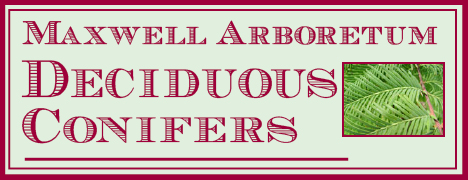
Larix decidua (European Larch) | Taxodium distichum (Baldcypress) | Metasequoia glyptostroboides (Dawn Redwood)
Deciduous Conifer Map
back to Deciduous Conifer main page
Taxodium distichum (Baldcypress)
Along with the one remaining Cottonwood planted by Earl Maxwell, I think of the Baldcypresses in Maxwell Arboretum as its signature tree. What was he thinking when he planted several of these swamp trees of the southeastern United States up here in a prairie state?
Some of us prairie folks tend to think of baldcypress swamps with their odd "knees" growing out of the water and Spanish Moss hanging like old cobwebs as more than slightly creepy places. But here in Maxwell Arboretum, our Taxodium distichum trees, while massive weighty things, have a light airiness to them. It's true that they're some of the most water tolerant trees in the United States (it's thought that their "knees" are some form of gas exchange mechanism that keeps them from drowning) but they grow with health and vigor here and are some of our largest trees. The species does so well that the Nebraska Statewide Arboretum named Baldcypress as their Tree of the Year in their Great Plants for the Great Plains program.
There are three large Baldcypress in Maxwell proper and one just outside the arboretum at its north entrance. Along with the cottonwood and the large oaks they seem to anchor the arboretum. These three large trees were all planted by Earl G. Maxwell, probably in the early 1940s. At the north end of Arbor Creek, you'll find the State Champion Taxodium distichum. When it was nominated for the Nebraska Forest Service's State Champion Register in 2000, the following statistics were provided:
Circumference: 13.00 ft
Height: 56 ft
Spread: 57.75 ft
Altough severely damaged in the storm of 1997, this specimen tree is still an impressive sight. The tree is dedicated to Wilbur "Bud" Dasenbrock, former Director of UNL's Landscape Services Department.
One of the more prescient things I did while Grounds Supervisor in Maxwell Arboretum was to notice two very small Baldcypress seedlings growing just to the southeast of the State Champion Baldcypress. I was head down with a a backpack sprayer applying herbicide to weeds in the tree's mulch bed but, fortunately, I was able to stop spraying right before I hit them. After one of these seedlings was eaten by rabbits, I erected a protective fence around the other. The seedling is now several years old and many feet. Being self-planted, it is a very happy healthy thing. Humans just can't plant a tree the way that nature does.
We can now be assured, barring any unforeseen problems, that the arboretum will have the progeny of Maxwell's original planting for many, many more years.
The new baby Bladcypress
In the fall of 2012, as part of a larger tree planting effort funded through an American Forests grant that the Friends of Maxwell Arboretum received, a new Baldcypress was planted in the arboretum. The cultivar, Shawnee Brave® ('Michelson') , was introduced by Earl Cully and is distinct due to its narrow pyramidal habit. Locate the tree using the Map of the Fall 2012 FOMA Plantings.
From A Reunion of Trees: The Discovery of Exotic Plants and Their Introduction into North American and European Landscapes. Stephen A. Spongberg. Cambridge: Harvard University Press, 1990 [Find it at CYT Library: SB435.65 SS66 1990]:
Spongberg begins his first chapter with a look at T. distichum as an example of an "exotic" to New England--it grows at the Arborway Gate of the Arnold Arboretum.
"The bald cypress was one of the first strange and unknown trees encountered by the settlers who attempted to establish the Roanoke Colony. It was noted in written documents by Thomas Hariot on his return from the Roanoke Colony in 1588 and by William Strachey, who visited Jamestown in Virginia in 1610. Native to swamps and bays, where it commonly grows in quiet waters or on low, periodically flooded ground, this tree is characteristic of maritime forests of the Coastal Plain of the southeastern United States. . . . Throughout much of its native range the bald cypress is festooned with Spanish moss--not really a moss at all but an epiphytic bromeliad--and images of these trees evoke the atmosphere of the antebellum South or of alligator-infested swamps."
Illustration from Spongberg
Taxodium distichum (Baldcypress) Gallery
don't turn all at once